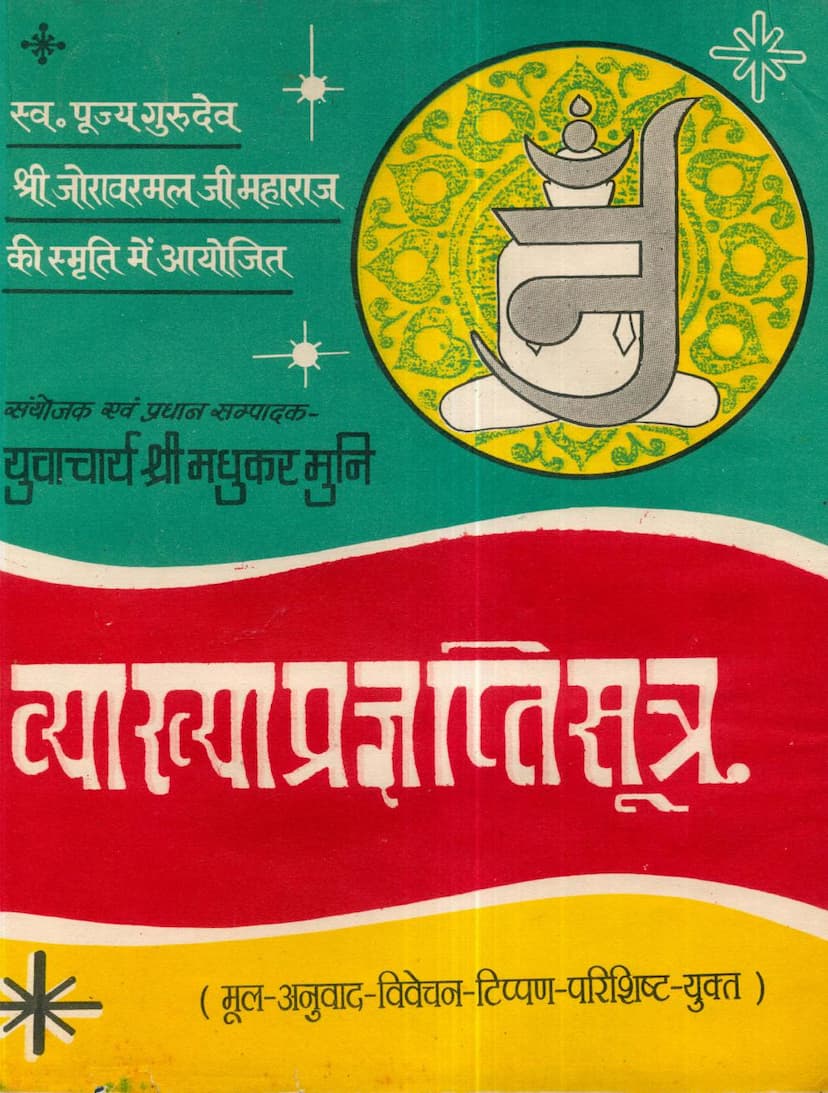Agam 05 Ang 05 Bhagvati Vyakhya Prajnapati Sutra Part 01 Stahanakvasi
Added to library: September 1, 2025

Summary
The provided text is the beginning of the Bhagvati Sutra, specifically Volume 1, Anga 5 of the Jain Agamas, compiled by Madhukarmuni. Titled "Agam 05 Ang 05 Bhagvati Vyakhya Prajnapati Sutra Part 01 Stahanakvasi," it is published by Agam Prakashan Samiti. The text is presented as the third edition, published in March 2002, coinciding with Vir-Nirvana Samvat 2528 and Vikram Samvat 2058.
The book is dedicated to the memory of Gurudev Sri Joravarmalji Maharaj and inspired by the late Up-pravartaka Shasansevi Swami Sri Brijlalji Maharaj. The convener and founder editor is the late Yuvacharya Sri Mishrimalji Maharaj 'Madhukar'. The work of editing, annotating, and translating is attributed to Shri Amarmuni and Shri Chand Surana 'Saras'.
Key aspects of the text as presented in these pages:
- Title and Content: The book is the first part of the Bhagvati Sutra, also known as Vyakhyaprajnapti Sutra. It is the fifth Anga of the twelve Angas of Jinagam, compiled by Ganadhara Sudharma Swami. It is described as a "Granthraj" (king of books) due to its solutions to various philosophical questions and curiosities.
- Structure: The Bhagvati Sutra contains 36,000 questions and answers given by Lord Mahavir to Ganadhara Gautam Swami and other monks and nuns. It is divided into many Shatakas (chapters) and further into sub-chapters. The primary style of discussion is in question-answer format.
- Purpose of this Edition: The Agam Prakashan Samiti aimed to create a publication that incorporated the best features of various existing editions, some being too detailed and others too brief, to be accessible to the general public. This third edition is being published due to popular demand from libraries and scholars.
- Dedication: The book is dedicated to Acharya Shri Dharmadasji Maharaj, who is described as an extraordinary personality of his era, dedicated to the practice of Jain dharma, the propagation of Jinavani (Jain scriptures), and the enlightenment of the Jain order.
- Author and Contributors: The author is Yuvacharya Shri Madhukarmuni. The editorial board includes Munishri Kanhaiyalalji 'Kamal', Upacharya Sri Devendra Muni, and Shastri Shri Ratan Muni. Other contributors include Munishri Vinayakumar 'Bhima' (Promoter), Shri Devkumar Jain (Correction and Supervision), Shri Amar Muniji and Shri Chand Surana 'Saras' (Editors & Annotators).
- Inspirational Figures: The publication is associated with the remembrance of Late Guru Sri Joravarmalji Maharaj and the inspiration of Late Yuvacharya Sri Mishrimalji Maharaj 'Madhukar'. Late Shravak Chiman Singhji Lodha and Late Sri Pukhrajji Sisodiya are also mentioned as inspirational sources for the Agam Committee's work.
- Textual Approach: The edition aims for textual purity by following the Viyahpannatti Suttam published by Shri Mahavir Jain Vidyalay, Mumbai, which includes original text, annotations, सूत्र numbers, alternate readings, and special interpretations. Each sutra's question and answer are presented separately. Section titles and subtitles are provided for clarity. Difficult words are explained in parentheses. The commentary (Vicharan) is based on the renowned commentator Acharya Abhaydev Suri's Vritti. Extensive research and comparative annotations from Jain, Buddhist, Vedic, and other scriptures are included where necessary.
- Content of the First Chapter (Shatak): The initial pages detail the introductory elements, the first chapter (Shatak), and its ten divisions (Uddeshakas). The first Uddeshaka, "Chalanam," begins with a mangalacharan (auspicious invocation) and then delves into discussions about movement, karma principles, celestial beings (naraka, deva, nagakumara, etc.), various life forms (earthly, water-bodied, fire-bodied, air-bodied, plant-bodied), and their states of existence. It covers topics like the duration of life in different realms, the nature of their bodies, their motivations (krodhopayukta, etc.), and the binding of karma.
- Key Philosophical Concepts Discussed: The initial chapters touch upon concepts like:
- The nature of karma and its effects.
- The states of existence in different hellish realms and heavens.
- The concept of life-forms and their characteristics (e.g., plant-bodied beings, touch-sensed beings).
- The philosophical discussion on cause and effect in relation to actions (karma).
- The meticulous classification of phenomena and the detailed answering of intricate queries, characteristic of the Bhagvati Sutra.
- The philosophical concept of 'movement' and 'non-movement' in relation to karma and soul.
- The nature of beings and their existence in different realms, including the intricate details of their lifespans, sensory perceptions, and karmic bindings.
- The text also includes discussions on the nature of various deities, their realms, and their subtle powers, often referencing other scriptures for detailed explanations.
- Language and Structure: The text is in Sanskrit and Prakrit, with extensive Hindi explanations, annotations, and appendices. The language is scholarly and detailed, reflecting the depth of Jain philosophy and cosmology.
- Relevance: The text serves as a foundational scripture in Jainism, covering a vast spectrum of knowledge about the universe, cosmology, philosophy, ethics, and the path to liberation.
In essence, these initial pages of the Bhagvati Sutra introduce the work, its significance, its lineage of scholarship, and the profound and intricate nature of its philosophical and cosmological content, starting with the very first discussions on fundamental principles and the states of existence.